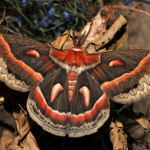Cecropia Moth
 When looking at and remembering history, we are too often forced to look at it in human terms but, plants, insects and animals have always had their own influences, in in some instances, very serious impact on human history. In this case, I had a very interesting and beautiful encounter with an insect in the Bertram Lakes area.
When looking at and remembering history, we are too often forced to look at it in human terms but, plants, insects and animals have always had their own influences, in in some instances, very serious impact on human history. In this case, I had a very interesting and beautiful encounter with an insect in the Bertram Lakes area.
It was the summer of 1990, while supervising some summer youth employment students. We were engaged in some cleanup near the beach area of Bertram Lake. A storm had come through and left some of the oak trees with broken branches and scattered leaves. One of the older trees ha d received a lightning strike that left it in fairly bad shape. We had decided that it needed to come down and proceeded to trim all the branches away. As I began using the chainsaw on the upper trunk, I felt little resistance to the saw. It soon became apparent that the tree was hollow and in fact, very hollow. After cutting several feet off the upper trunk we could look inside and see that the entire bottom was covered, 3 feet deep, with course sawdust. In looking through the sawdust, I found several (6-10) very large larvae, all about the size of a finger. They were off-white with a faint green hue and about 3/4 of an inch thick. They could be nothing less than the larvae of the Cecropia Moth. The largest of the moth family in North America. Recognizing this, we stopped cutting, covered the top with branches and leaves and left it alone until the next year.
d received a lightning strike that left it in fairly bad shape. We had decided that it needed to come down and proceeded to trim all the branches away. As I began using the chainsaw on the upper trunk, I felt little resistance to the saw. It soon became apparent that the tree was hollow and in fact, very hollow. After cutting several feet off the upper trunk we could look inside and see that the entire bottom was covered, 3 feet deep, with course sawdust. In looking through the sawdust, I found several (6-10) very large larvae, all about the size of a finger. They were off-white with a faint green hue and about 3/4 of an inch thick. They could be nothing less than the larvae of the Cecropia Moth. The largest of the moth family in North America. Recognizing this, we stopped cutting, covered the top with branches and leaves and left it alone until the next year.
I can only hope that they all survived. I was very happy and awed to see how nature compliments itself by providing what is necessary for its components to survive. Beauty isn’t always in what we can see, but it’s hidden all around us!


